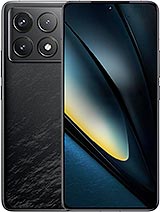Poco F6 review

HyperOS with Android 14
The Poco F6 runs on the latest installment of HyperOS and Android 14 and if you come from a MIUI-powered Xiaomi, you will feel right at home. The software isn't much different from the last few iterations of MIUI, but it does appear to be more polished and Xiaomi claims some under-the-hood optimizations as well.
Regarding software support, Xiaomi promises at least three years of major updates for both F6 and F6 Pro devices and one extra year of security updates..

We've covered the new HyperOS extensively in our detailed review and most of the features you'd see there are available on the Poco as well. However, keep in mind that there's still feature disparity across different Xiaomi devices and Poco phones have had slightly different approach than the rest of the Xiaomi phones.

The gap has narrowed over the years, though, and there are only some trivial changes in the Poco variant of MIUI and HyperOS. For instance, Poco smartphones come with the app drawer enabled by default and you can double-tap an empty space on the home screen to lock the device. Strangely, this feature isn't available on Xiaomi and Redmi devices running the global version of HyperOS.
It's perhaps important to note that the future AI-powered features, which are still in beta, will be available to the Poco F6 and F6 Pro once they are official.
And as far as performance is concerned, the Poco F6 handles the rather UI-heavy HyperOS with ease. We didn't have any slow-downs, hiccups or stutters.
Benchmark performance
The Poco F6 is one of the first Snapdragon 8s Gen 3-powered handsets, and it's definitely the first device to enter our office. Although it may sound like a binned Snapdragon 8 Gen 3 Soc, it's actually a fundamentally different chip. The 4nm manufacturing process is the same, though.

First off, the SoC employs a 1+4+3 CPU. The main Cortex-X4 core is still at the helm, ticking at a lower 3.0 GHz frequency (compared to the original SD8 Gen3), while the cluster of 4 Cortex-A720 cores runs at 2.8 GHz. The high-efficiency 3x Cortex-A520 cores are clocked at 2.0 GHz. The GPU on board is the Adreno 735 and the model name implies it sits lower than the Adreno 740 found in the Snapdragon 8 Gen 2 SoC.
Qualcomm also lowered the cost by using an older modem, but it's still offering a high-end ISP as well as next-generation connectivity such as Wi-Fi 7.
The available memory options are just two - 8GB/256GB and 12GB/512GB, and, in both cases, you will be getting speedy UFS 4.0 storage.
Now let's see how it fares in benchmark tests.
There's nothing a lot to discuss here as the Poco F6 and the F6 Pro outclass their competitors by a comfortable margin in terms of raw performance. The Poco F6 makes a particularly good case for itself by getting really close to the Snapdragon 8 Gen 2-powered Poco F6 Pro, while asking for less money.
Sustained performance
The Poco F6 handles the SD8s Gen 3 quite well in prolonged usage scenarios. In our CPU throttling test, the handset maintained about 83% of its theoretical max performance and remained relatively cool on the outside, thanks to its predominately plastic build.
Our only concern is the way it handles thermal throttling in general. Notice how the graph becomes inconsistent after the first 10 minutes or so. Sudden dips in CPU clocks stable framerates in games.
GPU stability was also pretty okay in general, as the device achieved 77% in 3DMark's GPU Wild Life stress test.
Reader comments
- Mohamed Hatem
- 29 Mar 2025
- CIB
The only downside from my previous poco x3 pro is the ultra wide camera it's was superior in x3 pro it was even capable or 1080p@60fps Meanwhile the f6 ultra wide camera is only 1080p@30fps
- Anonymous
- 17 Jan 2025
- rJe
is it ois camera..?















